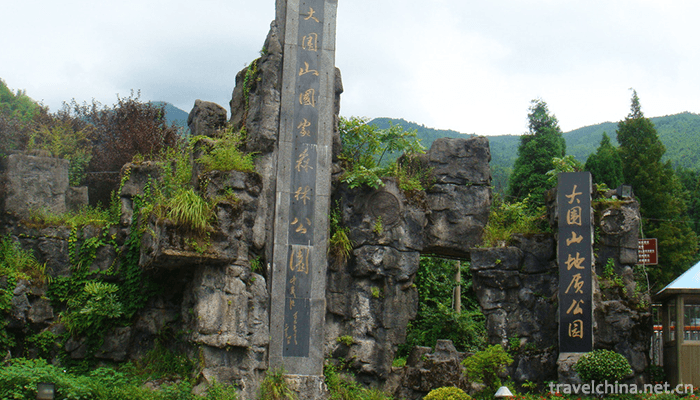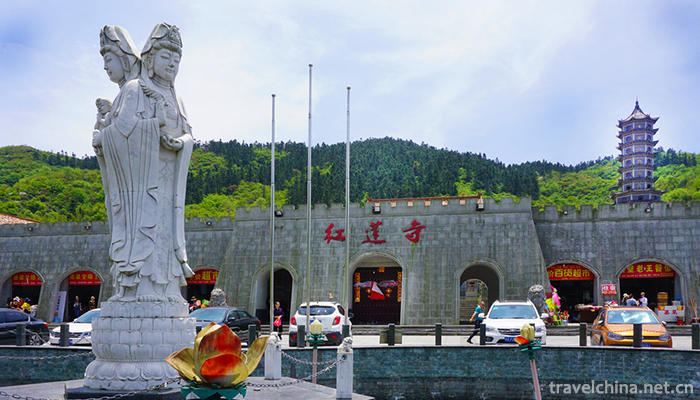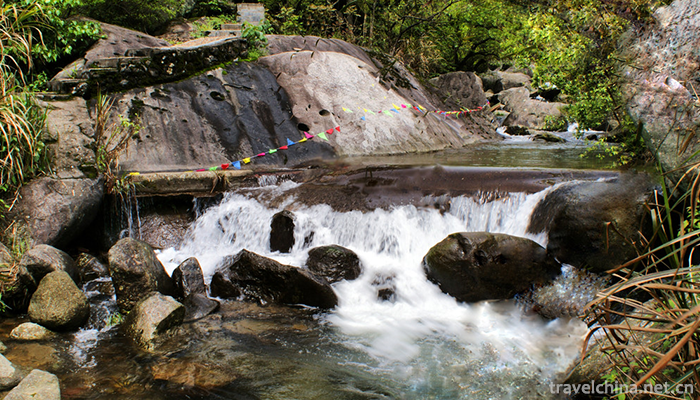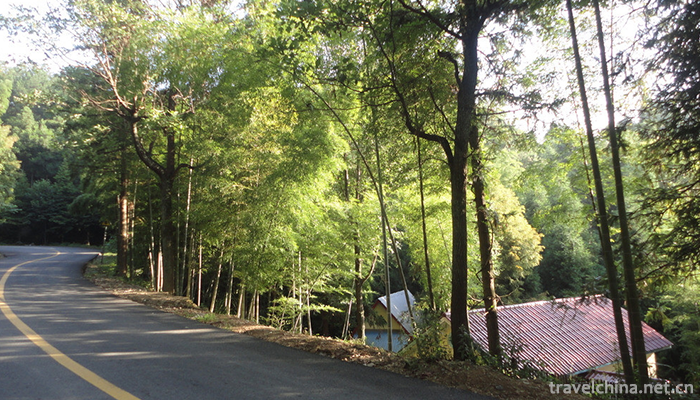Daweishan National Forest Park
Dawei Mountain is located in the boundary between Hunan and Jiangxi Province, the hinterland of Lianyun Mountains, the East is Tonggu County under the jurisdiction of Yichun City, Jiangxi Province, and the northwest is the northeast of Liuyang City, Hunan Province. It is not only the birthplace of Liuyang River, but also the first peak in eastern Hunan, with the main peak Qixing Peak at 1607.9 meters above sea level. It is 119 kilometers away from Changsha and 67 kilometers away from Liuyang.
In 1992, it was approved by the former Ministry of Forestry to develop and construct the National Forest Park, which was officially opened on August 1, 1996. June 8, 2007 was rated as Grade 4A Scenic Spot. In June 2012, Dawei Mountain passed the National Geopark Assessment.
Highway: Changsha-Nanchang Expressway.
Historical evolution
During the Tang and Song Dynasties, Buddhist culture was widely spread in eastern Hunan. The incense on Dawei Mountain in the hinterland of Lianyun Mountains was flourishing. Many high-ranking monks came to visit the temple for clean-up, and there were more than 100 monks and pilgrims in the temple.
In September 1927, the Autumn Harvest Uprising decided by the Eighty-seventh Conference began in Baisha Town, Dawei Mountain. Mao Zedong, Peng Dehuai, Hu Yaobang and Wang Shoudao, the older generations of proletarian revolutionaries during the Great Revolution, had left glorious revolutionary footprints in the area of Biantangao and Taoshuyan in Dawei Mountain. Dawei Mountain has left behind the old Soviet site of the province - Jinshoutang Ancient Architectural Complex, Baisha Shangping Conference site, Hunan, Hubei and Jiangxi First Party Congress site - Chudong Mountain Dawu and other red tourist attractions.
In 1958, the Daweishan Forest Farm was built.
Daweishan Nature Reserve was established in 1984.
In 1992, it was approved by the former Ministry of Forestry to develop and build into a national forest park.
The Park was officially opened on August 1, 1996.
June 8, 2007 was rated as Grade 4A Scenic Spot.
In June 2012, Dawei Mountain passed the National Geopark Assessment.
geographical environment
Daweishan National Forest Park is located in the northeast of Liuyang City, Hunan Province, 118 kilometers away from Changsha, the provincial capital. Daweishan National Forest Park covers an area of more than 70,000 mu.
natural resources
Biological resources
There are rich animal and plant resources, which can be called "natural animal and plant gene pool": there are 23 flora, more than 3000 species of plants, including 17 species listed in the first and second class of national protected plants; 68 species of wildlife, including 14 species listed in the first and second class of national protected animals, is a well-preserved flora and fauna in central and southern China, with more than 10,000 mu of Rhododendron sea and 5,000 mu of alpine meadow at the top of the mountain.
There are 23 flora, more than 2,000 species, 427 species of trees. Among them, 10 species are under state protection: Taxus chinensis, 7 species are under secondary protection: Xanthoceras, Cinnamomum, Chinese tallow, Goosepaw autumn, and 3 species are under tertiary protection: Magpie. There are more than 60 species of wild animals, including 14 species of protected animals in the first and second categories, clouded leopard, White-necked pheasant and pangolin and civet in the second level. There are more than 1200 kinds of reptiles and colorful butterflies in the forest, which can be called "natural animal and plant gambling". Museum of things.
The forest landscape with great ornamental value in the forest park includes Huangshan Songtao, Cuizhu Yanyun, Maple Forest Autumn, Cryptomeria sentiment, Alpine Rhododendron, Southern grassland, Eel's sole show, Hongji contend for beauty and so on.
Oxygen ion
Especially, the air quality of the park is excellent - the high content of negative oxygen ions can reach 20,000-40,000 units per cubic centimeter.
water resource
The water quality is excellent. It contains more than ten trace elements such as zinc, magnesium and potassium. It has the effect of health care and beauty.
Glacial ruins
The geological age of Dawei Mountain is old, and the Quaternary glacial geological relics and landforms are obvious and rich in resources. There are ice buckets, ice cellars, ice canals, fish ridges, U-shaped valleys, gourd valleys, ice slides, glacial scratches, glacial debris, ice tables, ice mortars and so on. They are of various types and are well preserved. Especially the 13 lakes of different sizes above 1300m are in the state of alpine wetland, which is formed by the ice cellar of Quaternary glacier. The 13 alpine lakes breed the great Liuyang River, which has important scientific research value and protection significance. Quaternary glaciers slowly moved the spherical weathered granite eggs to the mountains, forming a variety of boulders and boulders of different sizes and shapes, such as the mighty stones, remnants of the heavens, the great Buddha around the mountains, the wind-driven stones and other magnificent and peculiar landscapes.
Biological landscape
Mount Huangshan Songtao
Located on the southeast side of the boat bottom nest, at an altitude of 1250-1450 meters, there are more than 30 hectares of natural Huangshan pine forest. Although it is the main protected object of the nature reserve, its body on the great bank is vigorous and upright, its broad mind is selfless and fearless, as if it is not the protected object, but the tree of life extending through the green mulberry trees to protect the earth's pure land. Protecting the limited space on which human beings depend.
Bamboo waves
In Dawei Mountain, the bamboo forest covers an area of 600 hectares. There are bamboo oceans everywhere, and bamboo charms everywhere, no matter on the hills or under the hills or beside the rivers. She is always welcoming visitors from afar. Once put into her embrace, tenderness is endless and reverie. In spring, when the drizzle is drizzling, the bamboo smoke clouds, a nihility, wander among them, such as in fairyland. Humanitarian mottled bamboo a thousand tears, I say bamboo sea is a million feelings.
rhododendron lapponicum
At 1200 meters above sea level, there are dozens of miles of Alpine rhododendrons in Dawei Mountain. Red, yellow and purple are intertwined.
Southern grassland
There are more than 1000 hectares of grassland in the 1600-metre mountainous area of Dawei Mountain.
Autumn forest
The ancients often said: autumn night Autumn Lantern autumn dream long. The beauty of Autumn Dream in Dawei Mountain is the autumn color of Maple Forest. Whether you walk by a stream to cultivate your mind or climb a high horizon, maple trees and persimmon trees are red as blood, sometimes embellishing the green sea, or dyeing the mountains, when you meet the sunset, the sun is red as blood, and the leaves are red as blood, both of them are in one, but not as good as fairyland.
Cryptomeria fortunei
Located 500 meters north of the site, there is a pure plantation of Cryptomeria fortunei with an area of about 3 hectares. It was planted in 1982. Although it lasted only more than ten years, the average tree height has reached 12 meters and the average diameter at breast height is 15 centimeters.
Cluster of Goosefoot
Goose-paw tussle, also known as tussah, is a national second-class protected plant. It not only has important scientific research value, but also is an excellent ornamental tree species. Goose palms grow everywhere in Dawei Mountain, which is tens of square kilometers.
Tourist guide
Daweishan is located in the throat section of Hunan and Jiangxi, and the easternmost section of Liuda Expressway, which is the second horizontal section of Hunan Province's "five vertical and seven horizontal" expressway network planning. The Expressway starts at Pingshan, Changliu Expressway, and can be interchanged to connect with Nanchang-Tonggu Expressway in Jiangxi Province.







0 Questions
Ask a Question
Your email address will not be published.